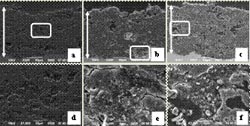Aluminum nitride coatings by atmospheric reactive plasma spray

SEM cross section images of the AlN coatings fabricated with using N2 plasma gas flow rate of: (a) 100, (b) 120, (c) 160 l/min and (d-f) are higher magnifications of the squared parts in (a-c).
For such applications fabrication of thick AlN coating by thermal spray into the chosen material surface considered to be suitable solution. However, it is impossible to fabricate AlN coating directly by conventional thermal spraying due to the AlN thermal decomposition without melting.
Here, Mohammed Shahien and colleagues at Toyohashi University of Technology, Japan report on the realization of cubic AlN coatings on steel substrates by atmospheric reactive plasma spraying of fine Al2O3 feedstock powder in N2/H2 plasma.
The formation process was clarified thus, during spray the particles melted, spheroidized and nitrided in the plasma to form the cubic aluminum oxynitride then cubic-AlN. Furthermore, using smaller particle size enhanced the surface (reaction) area and improved the nitriding conversion.
It was possible to fabricate thick and uniform coatings with high AlN content by spraying fine Al2O3/AlN mixture and the thickness increased from about 150 µm to about 200 µm with increasing the N2 gas flow rate from 100 to 160 l/min.
These results are important for the manufacture of high performance equipment for the materials manufacturing including semiconductors.
Reference
Authors: M. Shahien, M. Yamada, T. Yasui, M. Fukumoto
Title of paper: Aluminum Nitride Coating Fabricated by Reactive Plasma Spraying of Al2O3
Journal: Proceedings of Thermal Spray 2012: Proceedings from the International Thermal Spray Conference and Exposition.May 21–24, 2012, Houston, Texas, USA. Pages: 873-879.
Affiliation: Interface & Surface Fabrication Laboratory, Department of Mechanical Engineering
Media Contact
All latest news from the category: Process Engineering
This special field revolves around processes for modifying material properties (milling, cooling), composition (filtration, distillation) and type (oxidation, hydration).
Valuable information is available on a broad range of technologies including material separation, laser processes, measuring techniques and robot engineering in addition to testing methods and coating and materials analysis processes.
Newest articles

Trotting robots reveal emergence of animal gait transitions
A four-legged robot trained with machine learning by EPFL researchers has learned to avoid falls by spontaneously switching between walking, trotting, and pronking – a milestone for roboticists as well…

Innovation promises to prevent power pole-top fires
Engineers in Australia have found a new way to make power-pole insulators resistant to fire and electrical sparking, promising to prevent dangerous pole-top fires and reduce blackouts. Pole-top fires pose…

Possible alternative to antibiotics produced by bacteria
Antibacterial substance from staphylococci discovered with new mechanism of action against natural competitors. Many bacteria produce substances to gain an advantage over competitors in their highly competitive natural environment. Researchers…





















